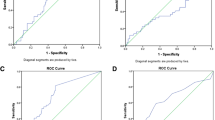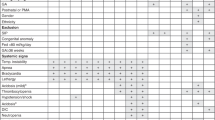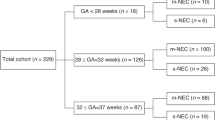Abstract
Objective
Necrotizing enterocolitis (NEC) is an inflammatory bowel disease of preterm infants marked by an absolute monocyte count (AMC) drop in peripheral blood. Our objective was to determine whether the degree of AMC drop at illness onset correlates with eventual severity of disease.
Study design
The percentage change in AMC was retrospectively calculated for each of 29 rule-out NEC and 76 NEC cases from baseline to illness onset, and then compared across stages.
Results
Median AMC changes of +0.5% (p = 0.56) were found in rule-out NEC, compared with −44.5% (p < 0.0001) in Stage 2 and −81.9% (p < 0.0001) in Stage 3. An AMC change cutoff of −75% distinguishes Stages 2 and 3.
Conclusions
The severity of NEC correlated with the extent of AMC change in a dose-response fashion. Percent AMC change may be a useful marker for identifying NEC at onset and prognosticating disease severity.
This is a preview of subscription content, access via your institution
Access options
Subscribe to this journal
Receive 12 print issues and online access
$259.00 per year
only $21.58 per issue
Buy this article
- Purchase on Springer Link
- Instant access to full article PDF
Prices may be subject to local taxes which are calculated during checkout




Similar content being viewed by others
References
Patel RM, Kandefer S, Walsh MC, Bell EF, Carlo WA, Laptook AR, et al. Causes and timing of death in extremely premature infants from 2000 through 2011. N. Engl J Med. 2015;372:331–40.
Niño DF, Sodhi CP, Hackam DJ. Necrotizing enterocolitis: new insights into pathogenesis and mechanisms. Nat Rev Gastroenterol Hepatol. 2016;13:590–600.
Hackam D, Caplan M. Necrotizing enterocolitis: pathophysiology from a historical context. Semin Pediatr Surg. 2018;27:11–8.
Mara MA, Good M, Weitkamp J-H. Innate and adaptive immunity in necrotizing enterocolitis. Semin Fetal Neonatal Med. 2018;23:394–9.
Neu J, Walker WA. Necrotizing enterocolitis. N Engl J Med. 2011;364:255–64
Remon J, Kampanatkosol R, Kaul RR, Muraskas JK, Christensen RD, Maheshwari A. Acute drop in blood monocyte count differentiates NEC from other causes of feeding intolerance. J Perinatol. 2014;34:549–54.
Condino AA, Barleycorn AA, Lu W, Maheshwari A, Christensen RD, Calhoun DA. Abnormal intestinal histology in neonates with congenital anomalies of the gastrointestinal tract. Neonatology. 2004;85:145–50.
MohanKumar K, Namachivayam K, Song T, Jake Cha B, Slate A, Hendrickson JE, et al. A murine neonatal model of necrotizing enterocolitis caused by anemia and red blood cell transfusions. Nat Commun. 2019;10. http://www.nature.com/articles/s41467-019-11199-5. Accessed 26 Aug 2019.
Lupton BA, Pendray MR. Regionalized neonatal emergency transport. Semin Neonatol. 2004;9:125–33.
Cantey JB, Milstone AM. Bloodstream Infections. Clin Perinatol. 2015;42:1–16.
Lam HS, Ng PC. Use of prokinetics in the preterm infant. Curr Opin Pediatr. 2011;23:156–60.
de Jong E, Strunk T, Burgner D, Lavoie PM, Currie A. The phenotype and function of preterm infant monocytes: implications for susceptibility to infection. J Leukoc Biol. 2017;102:645–56.
Kalhan TG, Bateman DA, Bowker RM, Hod EA, Kashyap S. Effect of red blood cell storage time on markers of hemolysis and inflammation in transfused very low birth weight infants. Pediatr Res. 2017;82:964–9.
Ellefson AM, Locke RG, Zhao Y, Mackley AB, Paul DA. Increased monocytes and bands following a red blood cell transfusion. J Perinatol. 2016;36:57–60.
Author information
Authors and Affiliations
Contributions
SD designed the study and performed data collection. JB and DB performed statistical analysis. SK guided study design. The paper was written by SD with significant contributions by SK and DB.
Corresponding author
Ethics declarations
Conflict of interest
The authors declare that they have no conflict of interest.
Additional information
Publisher’s note Springer Nature remains neutral with regard to jurisdictional claims in published maps and institutional affiliations.
Rights and permissions
About this article
Cite this article
Desiraju, S., Bensadoun, J., Bateman, D. et al. The role of absolute monocyte counts in predicting severity of necrotizing enterocolitis. J Perinatol 40, 922–927 (2020). https://doi.org/10.1038/s41372-020-0596-2
Received:
Revised:
Accepted:
Published:
Issue Date:
DOI: https://doi.org/10.1038/s41372-020-0596-2
This article is cited by
-
Gestational age-specific hematological features in preterm infants with necrotizing enterocolitis
Pediatric Research (2024)
-
Do hematological biomarkers predict surgical necrotizing enterocolitis?
Pediatric Research (2024)
-
Nomogram for predicting fulminant necrotizing enterocolitis
Pediatric Surgery International (2023)
-
Hematological predictors of mortality in neonates with fulminant necrotizing enterocolitis
Journal of Perinatology (2021)
-
Characterization of the pathoimmunology of necrotizing enterocolitis reveals novel therapeutic opportunities
Nature Communications (2020)



